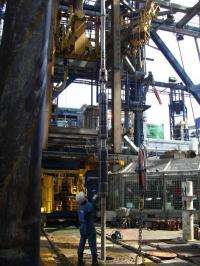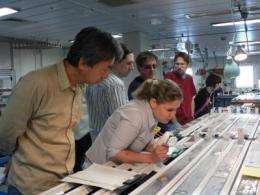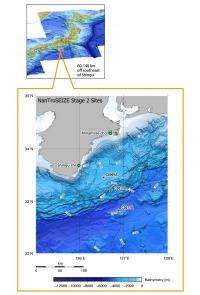Scientists return from first ever riser drilling operations in seismogenic zone

The Deep-sea Drilling Vessel CHIKYU successfully completed riser drilling operations on Aug. 31, for IODP Expedition 319, Stage 2 of the Nankai Trough Seismogenic Zone Experiment (NanTroSEIZE). The CHIKYU is operated by the Japan Agency for Marine-Earth Science and Technology (JAMSTEC) in partnership with the Integrated Ocean Drilling Program.
The expedition began with drilling operations at the Kumano Basin, off the Kii Peninsula on May 10, 2009. Expedition 319 marks the first riser drilling in the history of the scientific ocean drilling program, and the first subseafloor observatory operations for NanTroSEIZE. The expedition was led by four Co-Chief Scientists: Eiichiro Araki, Research Scientist of JAMSTEC; Timothy Byrne, Professor of the University of Connecticut, USA; Lisa McNeill of the University of Southampton, UK; and Demian Saffer, Associate Professor of Geosciences at The Pennsylvania State University, and was joined by scientists from eight countries.
Expedition 319 conducted drilling operations at three drill sites in the Nankai Trough. At the first Site C0009, located directly above the seismogenic zone where great earthquakes occur, scientists conducted the first riser drilling in IODP history and successfully drilled down to a depth of 1,603.7 meters beneath the sea floor. Riser-based drilling allowed the scientists to conduct several scientific operations unprecedented in IODP, including 12 successful measurements of stress and pore fluid pressure in the subsurface using the dynamic formation testing tool, a two ship seismic experiment using a dense seismic array in the borehole, real-time mud gas analysis, and laboratory analyses of drill cuttings that are generated as the drill bit penetrates through the formation. In addition, 57.87 meters of core sample (a cylindrical geological sample) were obtained from depths between 1,510 and 1,593.9 meters below the seafloor. The scientific party developed several new techniques for analyzing these materials, which will be essential for future riser-based drilling.

The stress and pore pressure measurements are critical to understanding the mechanics of active tectonic fault zones, but have previously been unavailable in the scientific ocean drilling. Successful deployment of the test tool to measure these quantities deeper within the upper plate and near major fault zones in future riser holes will constitute a major breakthrough in understanding subduction zone fault earthquakes.
Also a walk-away Vertical Seismic Profiling (VSP) involving the CHIKYU and JAMSTEC's Research Vessel KAIREI was conducted to characterize the structure of the seismogenic plate boundary below the borehole by utilizing an array of seismic sensors temporarily clamped inside the borehole. Air guns towed by the KAIREI generated seismic waves, and reflected seismic waves from the fault system were clearly observed by the borehole sensors. Experience from the VSP experiment will open the way to in-depth study of seismogenic faults that are beyond the reach of drilling.
At a second borehole (Site C0010), drilling crossed one of the major faults in the plate boundary, known as the mega-splay fault, at a depth of about 400 meters below the seafloor. This fault is a prime candidate for tsunami generation, and may have slipped in historical great earthquakes. During the drilling operation, scientists documented rock physical properties and gained information about stresses in the formation. The borehole was then cased and utilized for observatory operations for future long-term borehole monitoring. These included lowering of test instruments, as well as emplacement of a temporary sensor package that will monitor conditions in the fault zone in the next few years.

The new data from Expedition 319 indicate that the stresses in the upper plate reflect the forces acting on the earthquake generating fault zones below. The direction of the maximum stresses follows the direction of tectonic plate motion in most of the region, but rotates drastically in a very narrow region above the mega-splay fault. In addition, the rock units, and in particular the ages of the rocks obtained by examining microfossils and the sediment types observed in the drill cuttings, provide new constraints on the geologic history of the major fault zone and its activity level.
The CHIKYU is now berthed at the Port of Yokkaichi, where it is preparing for IODP Expedition 322 scheduled to sail on Sept. 4. Operations will include core sampling and logging for all layers in the formation, with an aim to better understand the initial state of geological input materials before they are entering the seismogenic zone.
More information: To learn more about NanTroSEIZE, visit www.jamstec.go.jp/chikyu/eng/E … ntroSEIZE/index.html
Source: Integrated Ocean Drilling Program Management International
















